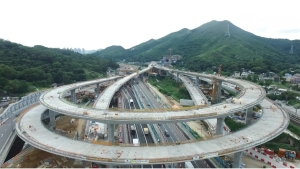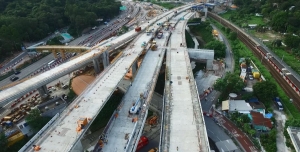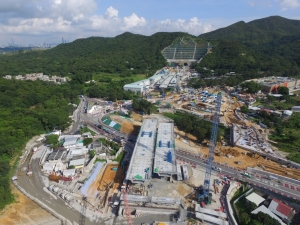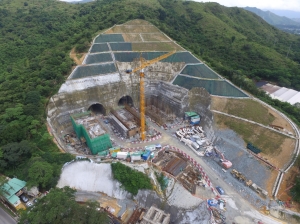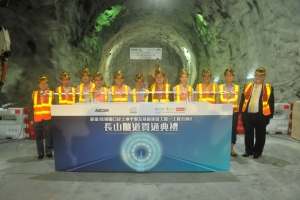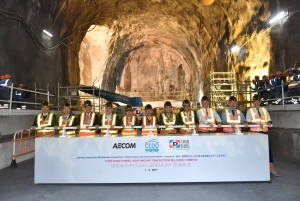Liantang/ Heung Yuen Wai Boundary Control Point – New control point, New milestone, New opportunities
|
A number of major infrastructure projects have been completed progressively since Hong Kong’s return to the motherland. Not only do they promote economic development and improve the livelihood of local residents, but also enhance Hong Kong’s long-term competitiveness. Among these is the Liantang/Heung Yuen Wai Boundary Control Point (LT/HYW BCP) - the seventh land-based border crossing between Hong Kong and Shenzhen, which is expected to be completed by the end of next year. Here I would like to introduce the work progress of this brand new control point and its benefits to be brought to the society. BCP abreast of the times Currently, we have to use the existing Man Kam To or Sha Tau Kok BCPs for access to the eastern parts of Shenzhen and Guangdong. Cross-boundary traffic has to navigate through the congested roads in both Hong Kong and Shenzhen before reaching the expressway network and heading for the destination. Such a scenario severely affects passenger and vehicular flows at the boundary crossings, as well as heaping further burden on the road traffic in the North East New Territories. Therefore, we have planned the LT/HYW BCP in the North East New Territories to divert cross-boundary traffic from the Man Kam To and Sha Tau Kok BCPs, as well as directly linking up the new BCP with Fanling Highway by developing a new connecting road to avoid the congested roads in the North District. Since commencing the project in April 2013, the project team and the contractors have been pressing ahead at full throttle on all construction sites, including various sections of the connecting road linking up the new LT/HYW BCP and Fanling Highway, as well as the passenger terminal building of the BCP, to strive for completion of works within next year. The southbound tube of Lung Shan Tunnel (Tunnel Boring Machine Section) under the LT/HYW BCP project broke through in March this year, while Cheung Shan Tunnel also broke through this month, marking a new milestone for the project. In every infrastructure project, there are difficulties and challenges which we would not underestimate. Early on in the design stage, the project team has taken into account the impacts of construction and operation on the communities and environment, such as minimizing the scale of private land acquisition and keeping the routing of the connecting road away from conservation areas such as country parks and woodlands. As a result, a “tunnel design” is adopted that 5.7 km of the connecting road will go beneath Lung Shan and Cheung Shan. This arrangement was made by the engineers after careful consideration. Enhancing the traffic flow Lung Shan Tunnel will be the major section of the connecting road of the LT/HYW BCP. This dual two-lane trunk road will connect with the Fanling Highway interchange and the Sha Tau Kok interchange. The 4.8 km long tunnel, 0.85 km longer than the Tate’s Cairn Tunnel, will be the longest road tunnel on land in Hong Kong. Traffic in the North District will be significantly improved upon completion of Lung Shan Tunnel, which will mitigate the busy road traffic in Sha Tau Kok and Ta Kwu Ling and thereby promote the long term development of the North District. In addition, the completion of the connecting road of the LT/HYW BCP will substantially improve the existing road network in the North District. The four interchanges along the connecting road will allow nearby residents to travel conveniently. In the future, residents at Sha Tau Kok and Ta Kwn Ling can also use the connecting road to travel to Sheung Shui, Tai Po and Kowloon via Fanling Highway. With the connecting road, travel time from Kau Lung Hang in Fanling to Loi Tung and Heung Yuen Wai in Sha Tau Kok, will be shortened significantly from the current average of 15 to 30 minutes to just four to eight minutes. Direct access for passengers and vehicles: convenient cross-border travel The LT/HYW BCP will also be the first BCP in Hong Kong to provide direct access for passengers and vehicles. Upon completion, it is expected to handle about 30 000 passenger trips and 17 850 vehicular trips daily. Apart from a public transport interchange, there will also be a drop-off area for private vehicles and a public car park on the bottom two levels of the passenger terminal building. As such, it will offer huge convenience to passengers as they can reach the passenger clearance hall to cross the border by private cars or on foot through the connecting pedestrian walkway. New industrial estate to be developed near the BCP The Government has already chosen a site of some 56 hectares in area near the LT/HYW BCP to develop a science park and an industrial estate. The project can help bring out the development potential of the border area to promote economic development and create more jobs in New Territories North, thereby rectifying the uneven distribution of job opportunities in Hong Kong. Hong Kong Science and Technology Parks Corporation (HKSTP) has commissioned a consultant to conduct a preliminary study on the feasibility of developing an industrial estate and a science park at the site, with the final report expected to be submitted in the second half of the year. Based on the study, the Government and the HKSTP will then consider the way forward of the project, including detailed designs, construction costs, timetable, as well as trade consultation, etc. Our infrastructural facilities have been crucial to Hong Kong’s success today. The Development Bureau will endeavour to implement cost-effective capital works projects as always. I look forward to the smooth and timely completion of the LT/HYW BCP, so as to offer a new option of convenient and comfortable cross-boundary facility to the public, as well as to improve the traffic network in the North East New Territories, promote economic development, create more job opportunities, and enable the public to enjoy the achievement of the project soonest. No boundary to efficiency (May 28, 2017): Southbound tube of Lung Shan Tunnel (Tunnel Boring Machine Section) under Liantang/Heung Yuen Wai Boundary Control Point project breaks through (March 1, 2017): |
|
16 July, 2017
Back